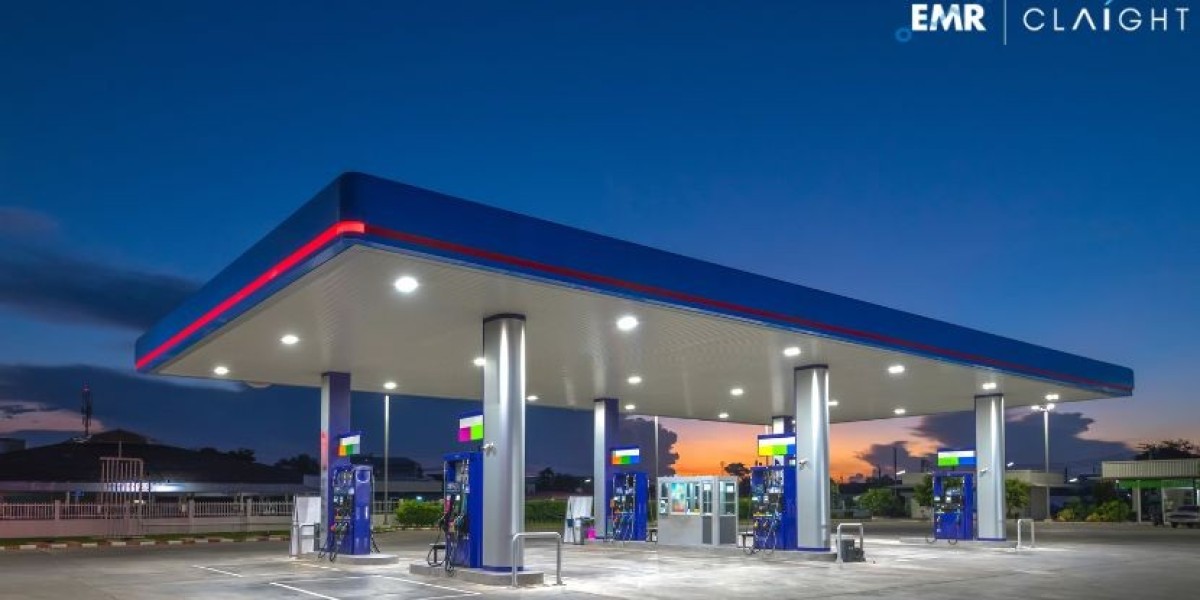Market Overview
The Saudi Arabia fuel station market size is projected to grow at a compound annual growth rate (CAGR) of 7.5% between 2025 and 2034. This growth can be attributed to several factors, including the growing population, an increasing number of vehicles on the road, and rapid infrastructure development. The demand for fuel stations will continue to rise with the expanding automotive sector, driven by both the public and private sectors. Additionally, rising consumer preferences for convenience and technological advancements in fueling stations are contributing to the growth of this market.
The expansion of urban areas and the government's focus on infrastructure development also provide opportunities for fuel station operators to expand their networks. The sector benefits from a highly supportive regulatory framework, aimed at boosting the economy and addressing the increasing fuel demand across various industries, including transportation, aviation, and shipping.
Market Trends
One of the significant trends in the Saudi Arabia fuel station market is the rise of alternative fuels. With the government's push towards sustainability, the demand for alternative fuel options such as natural gas and biofuels is growing. This trend is a response to the increasing global concern about the environmental impact of traditional fuels. Many fuel stations are now offering a broader range of fueling options, including electric vehicle charging points and LNG (Liquefied Natural Gas) stations. The government’s Vision 2030 plan, which emphasizes a shift towards greener technologies and cleaner energy, is expected to play a pivotal role in the acceleration of this trend.
Another key trend is the technological advancements in fuel station operations. Automation, digital payments, and AI-based fuel dispensing systems are transforming the way customers interact with fuel stations. These innovations not only improve operational efficiency but also enhance customer experience. Additionally, the growth of e-commerce and mobile apps has influenced the fuel retail market, making it easier for consumers to locate nearby stations, check fuel prices, and even pay for fuel using their smartphones.
Market Growth
The Saudi Arabia fuel station market is expected to experience robust growth driven by several key factors. First, the rapid urbanization and population growth are increasing the demand for transportation, which directly impacts fuel consumption. This growth is also spurring the construction of new road networks and infrastructure, leading to the establishment of additional fuel stations to meet the rising demand.
Second, the automotive sector in Saudi Arabia is witnessing an upward trend, with both private and commercial vehicle sales growing. This trend is particularly driven by an expanding middle class and an increase in government spending on infrastructure and transportation services. As more vehicles hit the roads, fuel demand will continue to rise, contributing significantly to market growth.
Moreover, the government's focus on Vision 2030 includes initiatives aimed at diversifying the economy, which will have a lasting impact on the fuel industry. Investments in infrastructure, public transport systems, and a move toward cleaner fuels will not only provide opportunities for fuel stations to grow but also allow for the emergence of new business models in the sector.
Segmentation of the Market
The Saudi Arabia fuel station market can be segmented by fuel type and end-use, with each segment playing a crucial role in shaping the market dynamics.
By Fuel Type:
Petrol: Petrol remains the dominant fuel type in Saudi Arabia, primarily driven by the increasing number of passenger vehicles on the road. The demand for petrol is also influenced by the lower cost of ownership and maintenance of petrol-powered vehicles compared to diesel or gas-powered vehicles.
Diesel: Diesel fuel is widely used in commercial vehicles, including trucks and buses. The segment is expected to grow steadily due to the increasing demand for goods and services, along with the expansion of industrial and logistical sectors.
Gas (LPG, CNG): With the increasing emphasis on environmental sustainability, gas fuels like LPG (Liquefied Petroleum Gas) and CNG (Compressed Natural Gas) are gaining traction. These fuels are seen as cleaner alternatives to traditional fuels, and their use is growing among both commercial and private vehicle owners.
Others: This segment includes alternative fuels such as electric vehicle charging and biofuels. With the government focusing on diversification and sustainability, this segment is expected to grow significantly over the next decade.
By End-Use:
Road Transport Vehicles: The largest end-use segment, road transport vehicles, includes personal cars, commercial vehicles, and public transport. As the Saudi population grows and urbanization continues, the demand for fuel for road transport is expected to remain high.
Air Transport Vehicles: Fuel consumption in the aviation sector, including airports and airlines, is another major driver of the market. Saudi Arabia’s strategic location as a global transit hub and increasing passenger air traffic contribute to the growing demand for aviation fuel.
Water Transport Vehicles: The marine sector, which includes cargo ships, tankers, and passenger vessels, is a critical part of the fuel market. Saudi Arabia’s vast coastline and the significance of its ports make this segment vital for fuel station operations.
Market Dynamics
SWOT Analysis
Strengths: Saudi Arabia's strategic location as a leading global oil producer ensures a steady supply of fuel, which is crucial for the fuel station market. The government’s support for infrastructure development and Vision 2030 initiatives also strengthens the market. Additionally, the high demand for fuel due to rapid urbanization and increased vehicle ownership ensures a steady growth trajectory.
Weaknesses: The dependence on oil exports and global oil price fluctuations expose the market to external risks. Price volatility in the global oil market can affect both fuel prices and the profitability of fuel station operators.
Opportunities: There is a significant opportunity for fuel stations to diversify their fuel offerings, including renewable energy options, electric vehicle charging stations, and LNG. Government initiatives supporting sustainable energy sources provide a long-term growth opportunity for fuel stations.
Threats: Geopolitical tensions, environmental regulations, and the transition to renewable energy are potential threats to the traditional fuel market. Increasing global awareness of climate change and the growing adoption of electric vehicles may decrease the demand for conventional fuels over time.
Porter’s Five Forces Analysis
Threat of New Entrants: The high capital requirements and regulatory barriers make it difficult for new entrants to establish fuel stations. However, the growing demand for fuel and the government’s push for infrastructure development may attract new players to the market.
Bargaining Power of Suppliers: Saudi Arabia’s position as a leading oil exporter means that fuel suppliers have significant power over pricing. However, diversification of fuel types (such as gas and electric) may reduce supplier power over time.
Bargaining Power of Buyers: As consumers become more price-sensitive and fuel-efficient vehicles become more popular, the bargaining power of buyers is increasing. Fuel station operators may need to adjust prices or offer additional services to remain competitive.
Threat of Substitutes: Electric vehicles and alternative fuels are posing a growing threat to the traditional fuel market. Government incentives for EV adoption and increasing consumer interest in environmentally friendly options are key challenges for the fuel station market.
Industry Rivalry: The competitive landscape in Saudi Arabia's fuel station market is highly fragmented, with several key players vying for market share. The rivalry is primarily focused on expanding fuel station networks and offering competitive prices.
Competitive Landscape
Key players in the Saudi Arabia fuel station market include:
Wafi Energy Company
ALDREES Petroleum & Transport Services Company
Petromin Corporation
TotalEnergies SE
ADNOC Distribution
ENOC Company
Saudi Automotive Services Co (SASCO)
Tas'Helat Marketing Company
Fuel Integrated Limited (Fuel Way)
Al-Atoz Petroleum Services Company
Liter Group
Others
These companies are leading the market through their extensive networks of fuel stations, innovative services, and competitive pricing strategies. Many of these companies are also diversifying their offerings to include alternative fuels and electric vehicle charging stations in line with the country’s sustainability goals.


